Exhibitions
MOMAT Collection (2025.11.5–2026.2.8)
Date
-Location
Collection Gallery, from the fourth to second floors
Highlights
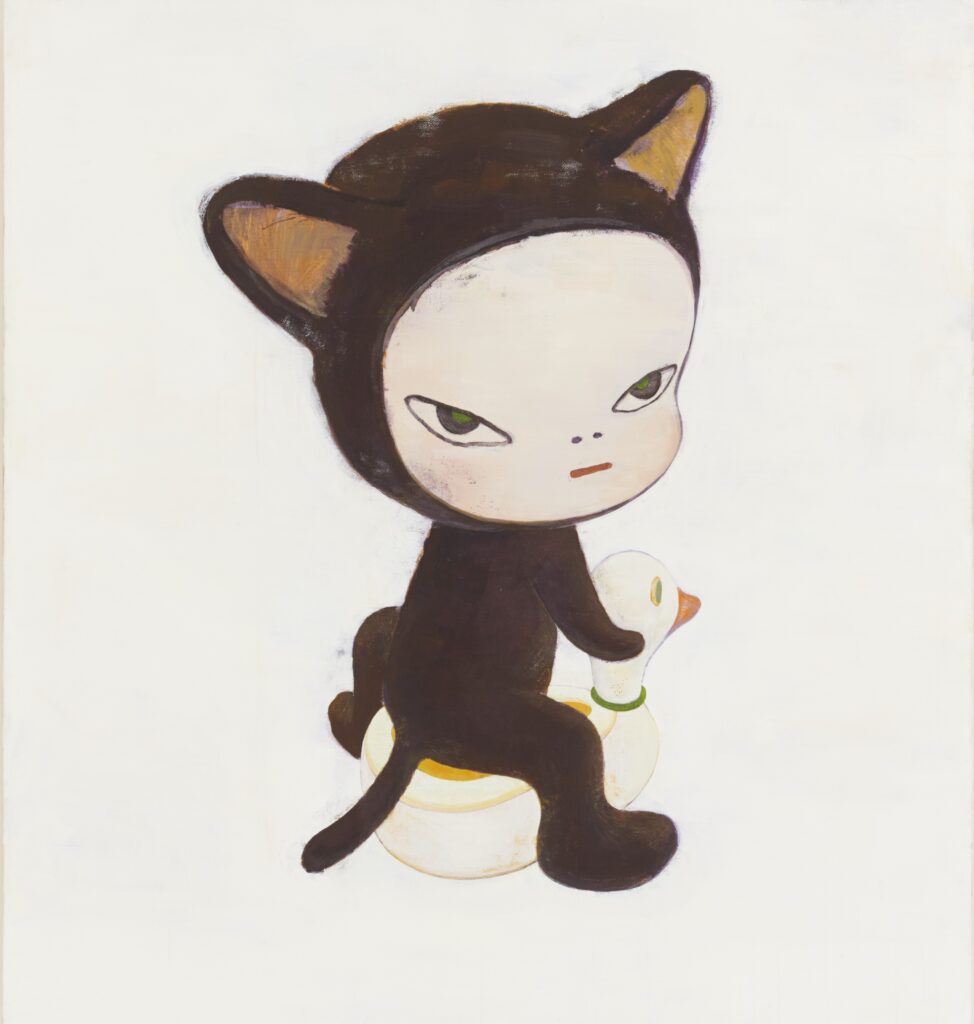
© Yoshitomo Nara
Welcome to the MOMAT Collection!
To introduce some features of the museum’s exhibitions of works from the collection: First, its scale is one of the largest in Japan, displaying approximately 200 works each term from the museum’s holdings of approximately 14,000 works acquired since its opening in 1952. Also, it is one of the foremost exhibitions in Japan, tracing the arc of Japanese modern and contemporary art from the end of the 19th century to the present day through a series of 12 rooms, each with its own specific theme.
Some highlights of the current term are as follows. Nara Yoshitomo’s Harmless Kitty (1994), which had been on long-term loan overseas, has returned to the MOMAT Collection for the first time in about two years. It is now on view in the Highlights section on the fourth floor. Room 9 on the third floor features photographer Hosoe Eikoh’s early landmark series Ordeal by Roses. This exhibit serves both as a tribute to Hosoe, who died in 2024, and as a commemoration of the 100th anniversary (in 2025) of the birth of novelist Mishima Yukio, the subject of the series.
Many newly acquired works are also on view this term. Look for the “New Acquisition” markers next to each work.
We hope you enjoy this rich lineup of works from the MOMAT Collection, where longtime highlights are joined by fresh new faces.
National Important Cultural Properties on display
The National Museum of Modern Art, Tokyo Collection contains 18 items that have been designated by the Japanese government as National Important Cultural Properties. These include twelve Nihon-ga (Japanese-style) paintings, five oil paintings, and one sculpture. (One of the Nihon-ga paintings and one of the oil paintings are on long-term loan to the museum.)
The following National Important Cultural Properties are shown in this period:
- Room 1 Harada Naojiro, Kannon Bodhisattva Riding the Dragon, 1890, Long term loan (Gokokuji Temple Collection)
- Room 1 Wada Sanzo, South Wind, 1907
- Room 2 Yorozu Tetsugoro, Nude Beauty, 1912
- Room 10 Kaburaki Kiyokata, Portrait of San’yutei Encho, 1930 (Exhibit Dates:November 5–December 21, 2025)

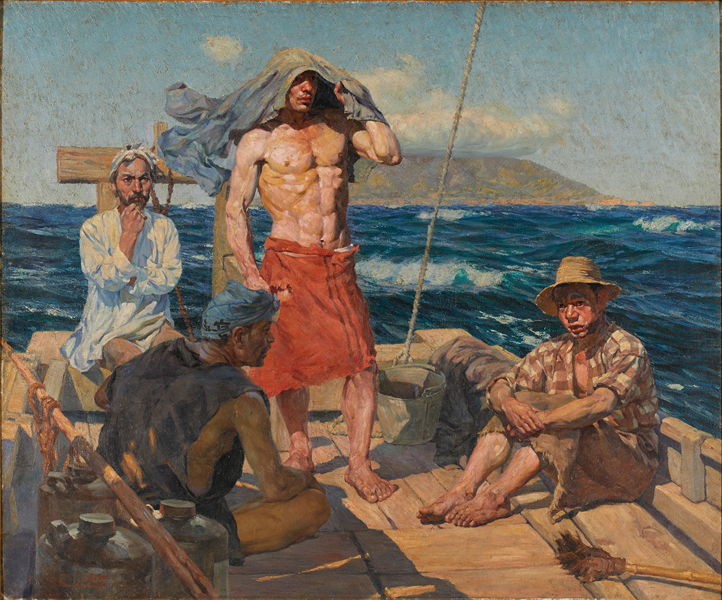
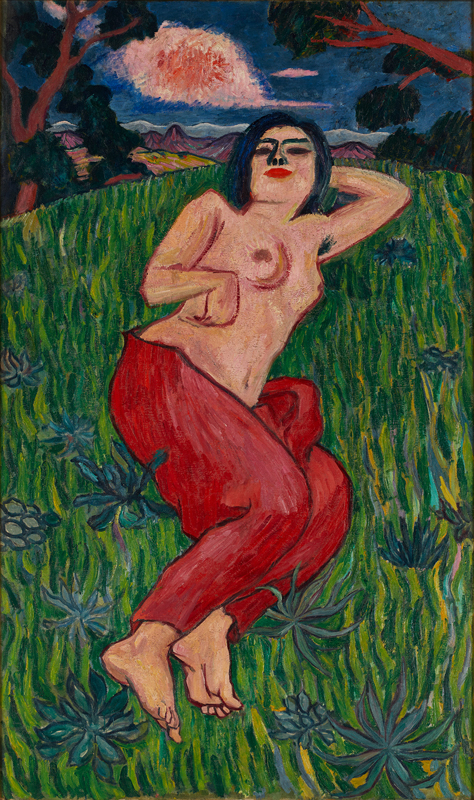
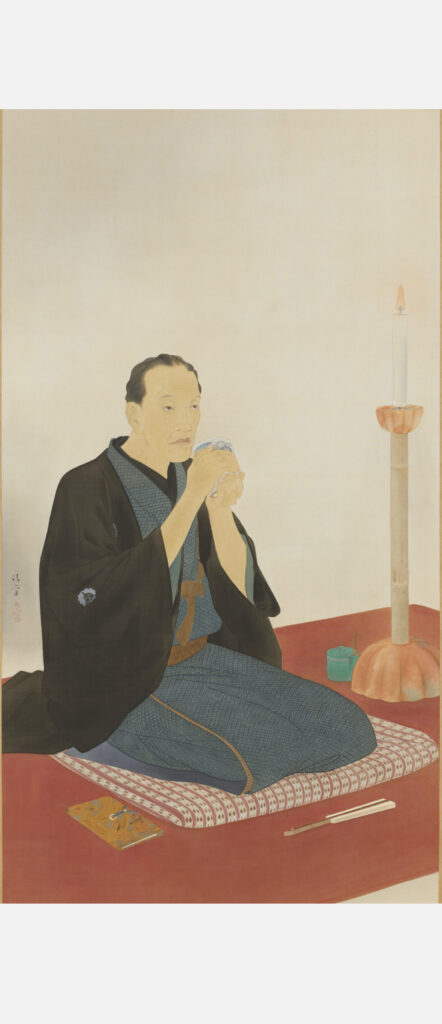
About the Sections
4F (Fourth floor)
A Room With a View
Located on the top floor of the museum, the rest area is furnished with Bertoia chairs, which can be compared to masterpieces of chair design. Please relax by the bright window. The large windows offer panoramic views of the greenery of the Imperial Palace and the Marunouchi skyline.
Information Section
Located in the introductory area, the Information Section presents a chronology of the MOMAT’s history, along with related materials. The materials on display are constantly being changed, so don’t miss them. The section also provides information on exhibitions at other museums that include works on loan from our museum, as well as a system for searching for works in our collection.
Room 1–5 1880s–1940s
From the Middle of the Meiji Period to the Beginning of the Showa Period
Room1 Highlights
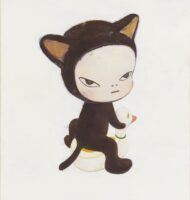
© Yoshitomo Nara
The MOMAT Collection exhibition of works from our permanent holdings features nearly 200 items in a 3,000-square-meter space. The “Highlights” section of this exhibition features highly prized works of modern and contemporary art that showcase the strengths of our collection.
This term, the Highlights section features several notable new acquisitions. In the Nihonga (Japanese-style painting) area, Kainosho Tadaoto’s White Lily and Woman (1920) is on view during the first half of the term (through December 21). The work reflects young Japanese painters’ admiration for Western art in the 1910s and 1920s. Outside the display case, Tiger Tateishi (Tateishi Koichi)’s Mao’s Ecstasy (1970) makes its debut here, encapsulating the essential elements of an artist also known for picture books and manga. Nara Yoshitomo’s Harmless Kitty (1994), which has spent the past two years on long-term loan overseas, also returns to the MOMAT Collection exhibition. We invite you to take your time and enjoy these alongside familiar favorites in this room, including Harada Naojiro’s Kannon Bodhisattva Riding the Dragon (1890), an Important Cultural Property, as well as works by Paul Cézanne and Pierre Bonnard.
Room2 New or Old?
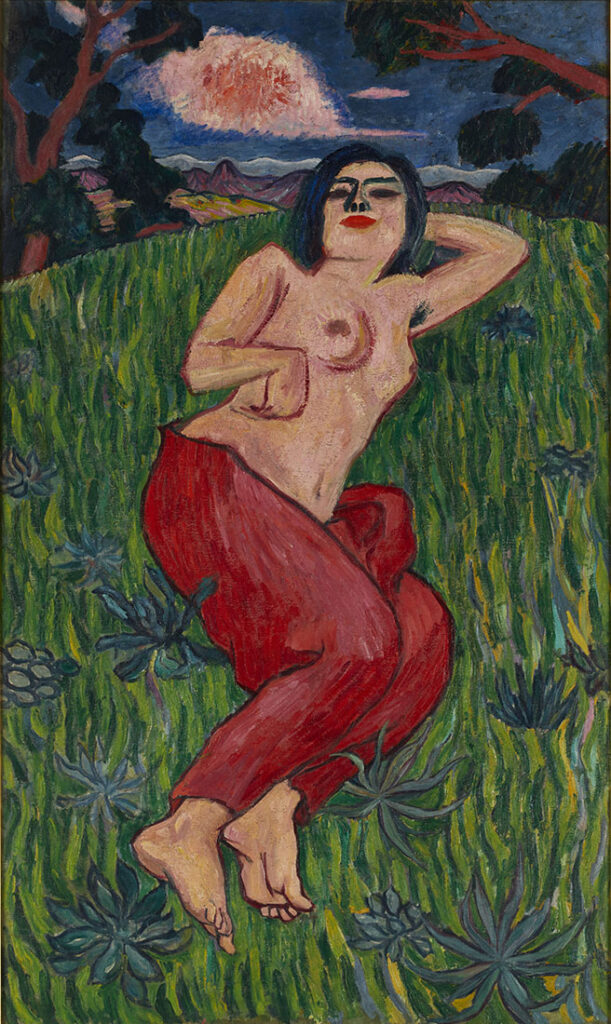
Determining the beginning of something is always a difficult task. The middle “m” in MOMAT stands for “modern.” But when did modern art really start? Half of these works were displayed in the Bunten, an annual exhibition launched by the Ministry of Education in 1907. Though opinions vary, some have suggested that this event marks the beginning of modern art in Japan.
This was an era in which modern meant “avant-garde.” In other words, the recent past was seen as something old that should be rejected and surmounted. Though the Bunten was initially welcomed, it soon became a stronghold for rigid Academicism and a target of criticism among the younger generation. The rest of these works were made by artists who intentionally veered away from the exhibition.
Do these works, created some 100 years ago, convey the feeling that new things are more magnificent than old ones or vice versa?
Room 3 Cubism Reexamined
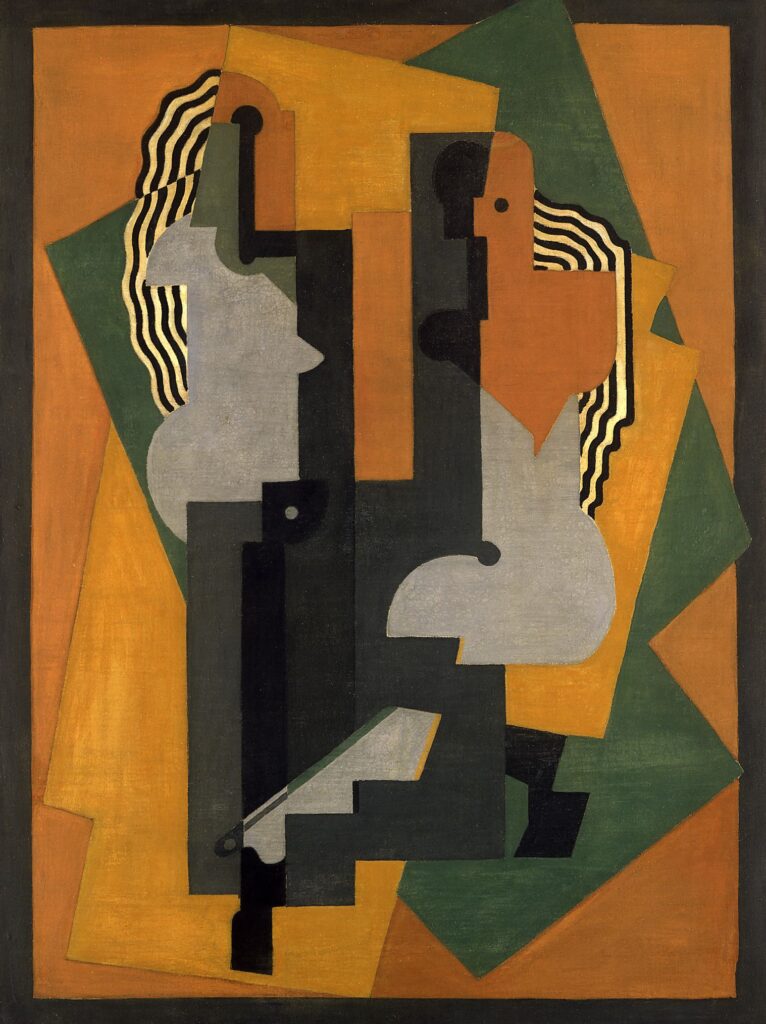
Cubism was a groundbreaking art movement that departed from traditional Western conventions, depicting motifs from multiple perspectives as groups of lines and planes. Emerging in Paris in the early 1900s, it was initiated by Pablo Picasso and Georges Braque, and further developed by numerous followers including Du “Cubisme” (1912) co-author Albert Gleizes, Juan Gris, and Natalia Goncharova, a leading figure in the Russian avant-garde. Cubism had a significant impact in Japan as well. Yorozu Tetsugoro is said to have encountered the movement early through art magazines. Kuroda Jutaro, who studied under Cubist painter André Lhote in France, and Maeta Kanji, who drew from the writings of Gleizes, flexibly incorporated Cubist techniques into their works. Focusing on the 1920s, a period when many Japanese artists traveled to France, this room reexamines approaches to Cubist exploration through painting in Japan and France.
Room 4 Bokuto Kidan
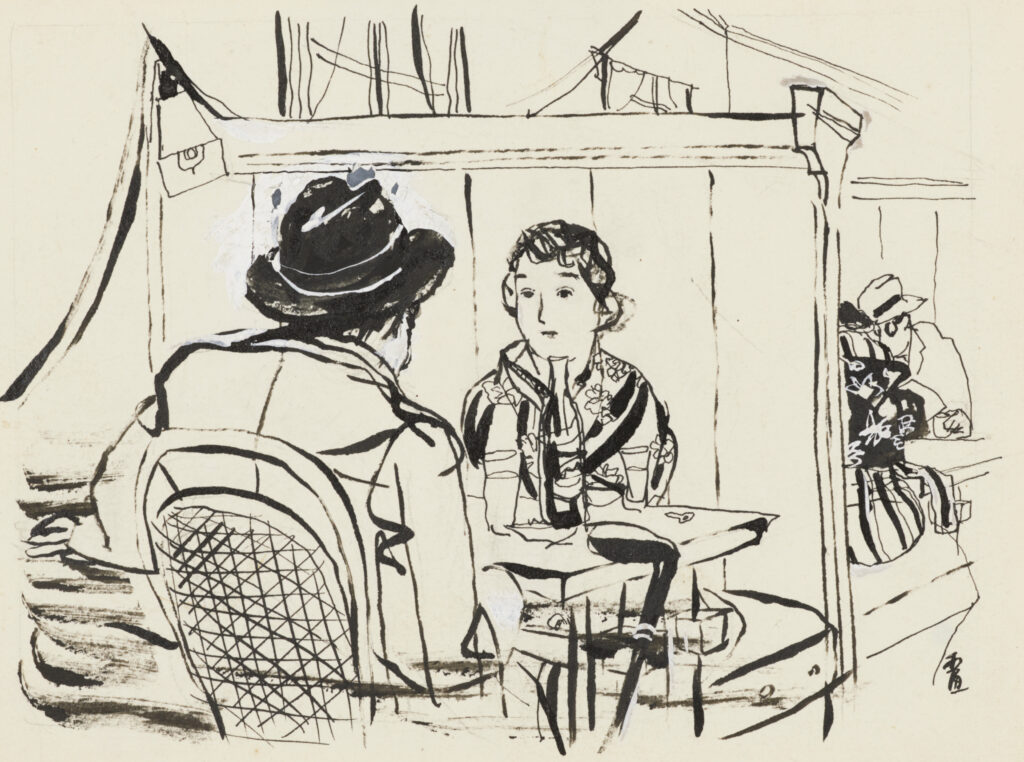
The aging novelist Oe Tadasu has gone to Tamanoi, a red-light district in the suburbs of Tokyo, in search of a good time. Rain begins to fall, and an unlicensed prostitute named Oyuki crashes into Oe’s umbrella. A relationship gradually develops between the two, but then Oe suddenly disappears. This is the basic plot of Nagai Kafu’s novel Bokuto Kidan (A Strange Tale from East of the River). The book was originally serialized in both the Tokyo and Osaka editions of the Asahi Shimbun newspaper from April to June 1937, with the illustrations by Kimura Shohachi exhibited here. It was thanks in part to Kimura’s illustrations that the book became one of Kafu’s most popular.
“Bokuto” refers to the area on the east bank of the Sumida River, today part of Tokyo’s Sumida Ward. Tamanoi (formerly known as Terajima-machi) was a district home to so-called meishuya (sake houses), which were ostensibly drinking establishments serving high-quality sake, but covertly functioned as brothels where unlicensed prostitutes worked. They were originally clustered in Asakusa, but from 1918 through the period following the 1923 Great Kanto Earthquake, they progressively moved to the vicinity of Tamanoi Station (present-day Higashi-Mukojima Station on the Tobu Isesaki Line). The meishuya of Tamanoi flourished during the years leading up to and during World War II, but they were virtually wiped out by the 1945 air raids on Tokyo, and no trace of them remains today.
Room 5 Painting in the 1930s: Between Reality and Illusion
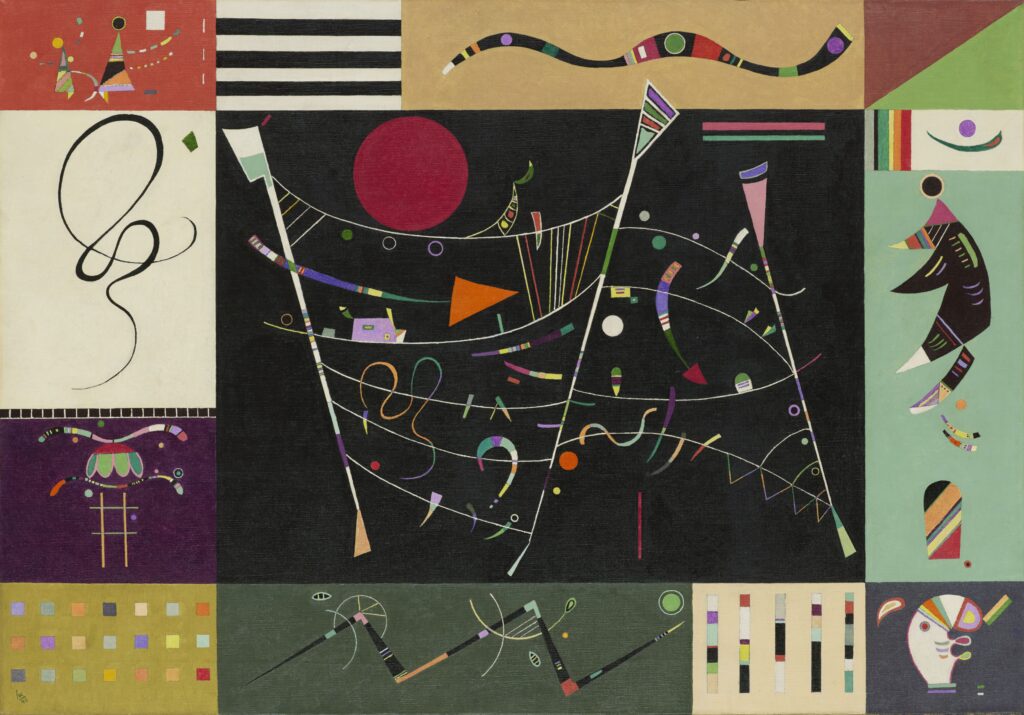
This room primarily features works produced from 1934 onward. Proletarian art (a leftist movement rooted in socialist and communist ideologies), which had been developing since the 1920s, faced frequent government suppression, and 1934 was a year of especially severe crackdowns. From then on, society grew increasingly repressive and the march toward war continued. In the face of harsh and agonizing realities, how did artists respond, and how did they express themselves in the public sphere?
The yearning for antiquity in Yamaguchi Kaoru’s Travel to Ancient Rome (1937) and the surreal worlds depicted in Kitawaki Noboru’s Airport (1937)and Migishi Kotaro’s Butterflies Flying above Clouds (1934) all suggest a desire to escape the here and now. Meanwhile, the piercing gaze of the fish and the bird in Yamashita Kikuji’s Salmon and Owl (1939), and the figure turned away in Fukuzawa Ichiro’s Double Image (1937), do not point beyond the present but instead confront the viewer directly, forcing a keen awareness of one’s own presence before the work. Also note the quiet resistance imbued in works such as Hasegawa Saburo’s Abstraction (1936), in which the artist distances himself from visible reality and embraces the abstract.
3F (Third floor)
Room 6-8 1940s–1960s From the Beginning to the Middle of the Showa Period
Room 9 Photography and Video
Room 10 Nihon-ga (Japanese-style Painting)
Room to Consider the Building (Sol LeWitt, Wall Drawing#769)
Room 6 Women in Wartime
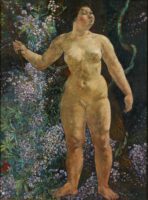
During the Second Sino-Japanese War and World War II, Japan adopted a total war system in which the roles of “men fighting at the front” and “women minding the home front” were promoted across all forms of media, including art, literature, and magazines. The image of women sustaining their households as “good wives and wise mothers” became widely accepted as a wartime gender norm. At the same time, women worked in munitions factories to manufacture weapons, while others were mobilized as military nurses and sent to the front. This room explores daily life during a time when war and the everyday were inseparable, and conveys the many roles women occupied in society through their portrayals in paintings and magazine illustrations.
The latter half of this area features works from the same period by female painters, including Transplanting by Asakura Setsu, a recent acquisition. In the art world during wartime, only men were commissioned by the military to produce War Record Paintings, while women painters were expected to focus on still lifes and genre scenes.
Room 7 On the Eve of Action
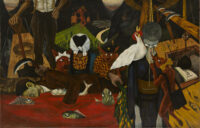
This exhibit is related to the exhibition Anti-Action: Artist-Women’s Challenges and Responses in Postwar Japan (December 16, 2025 – February 8, 2026), on view on the first floor. The Anti-Action exhibition reconsiders abstract art from the 1950s and 1960s through the lens of “action,” a term evoking forceful gesture. Titled On the Eve of Action, this room highlights key artistic tendencies from the end of World War II through the mid-1950s, offering a view of the Japanese art scene before the advent of international movements such as Action Painting.
The fragmented bodies in the works of Kawara On and Nakano Jun, presented like still-life objects, reflect the material and spiritual devastation of the postwar era and convey a kind of physicality that stands in stark contrast to action. Meanwhile, the reportage paintings of Yamashita Kikuji and Ikeda Tatsuo, which depict and document political and social realities of the time, emerged alongside abstraction and played a major role in shaping Japanese art of the 1950s.
Room8 “…Action!” & “…Cut!”
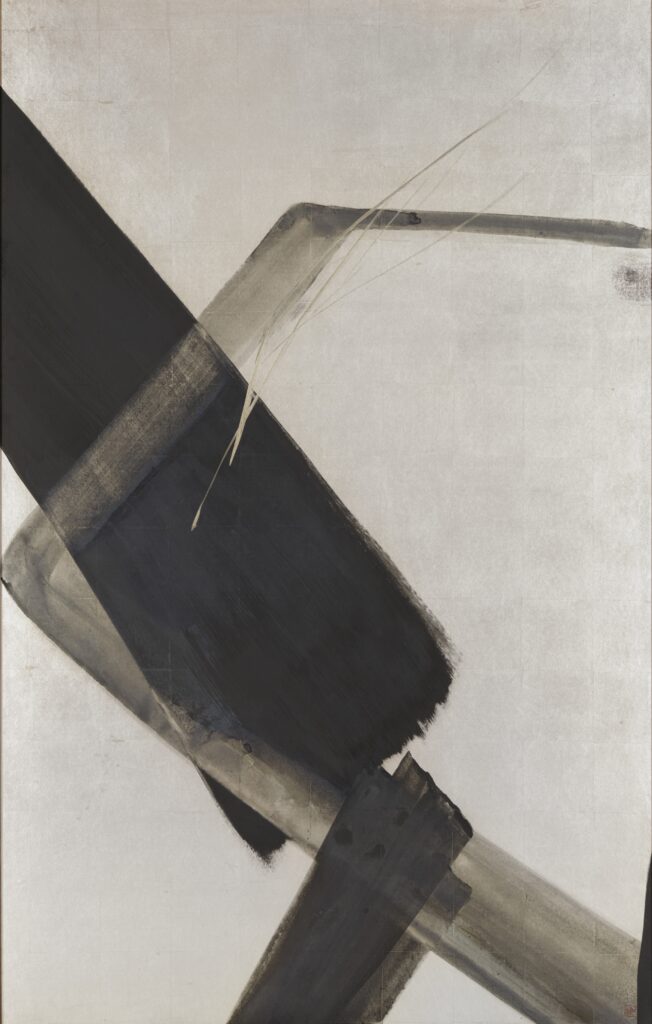
The Anti-Action exhibition on the first floor (December 16, 2025–February 8, 2026) reexamines abstraction in the 1950s and 60s through the lens of “action,” a term that calls to mind forceful physical gestures. This room presents works connected to “action,” the very approach that the “anti” in Anti-Action stands against. In the context of 1950s and 1960s art, “action” is rooted in “Action Painting,” a concept introduced in 1952 by American critic Harold Rosenberg to describe painting that emphasized the dynamic movements of the artist. Around the same time, Art Informel emerged in Europe and was soon introduced to Japan, where it had a major impact on the art world. On view here are a range of experiments involving action, including works representative of the tendency by Willem de Kooning and Shiraga Kazuo, calligraphy from the same period that conveys the artist’s spontaneous motion, and works by artists not included in the Anti-Action exhibition who engaged with “anti” in their own way.
Room 9 Hosoe Eikoh, Ordeal by Roses

These 11 works are from Ordeal by Roses, an early work by Hosoe Eikoh in which he explored fundamental themes of human existence such as life, death, and eros using the motifs of the novelist Mishima Yukio’s body and his idiosyncratic aesthetic sensibility.
Impressed by Hosoe’s pictures of the butoh dancer Hijikata Tatsumi (published in a photo book called Man and Woman), Mishima selected the photographer to take a portrait that was used to adorn a collection of the writer’s criticism. In the garden of Mishima’s house, where the shoot took place, Hosoe employed drastic staging such as wrapping a rubber water hose around Mishima’s naked torso. Deeply satisfied with these brilliant and highly finished works, Mishima agreed to Hosoe’s request for an additional shoot. Taken over a period of about two years, the resulting works were published in the 1963 photo book Ordeal by Roses.
Hosoe’s genius lay in his ability to identify the perverted impulses to suffer and self-destruct that were concealed within Mishima, who proudly displayed his physical beauty, and to use a variety of settings to illuminate these qualities. This aim was embodied by the beautiful but thrown-encrusted rose motif. The title Ordeal by Roses was devised by Mishima, the key player in this bizarre artistic world.
Room 10 (First term) 1950s–60s: Biomorphic Sculpture / The Person and the Art
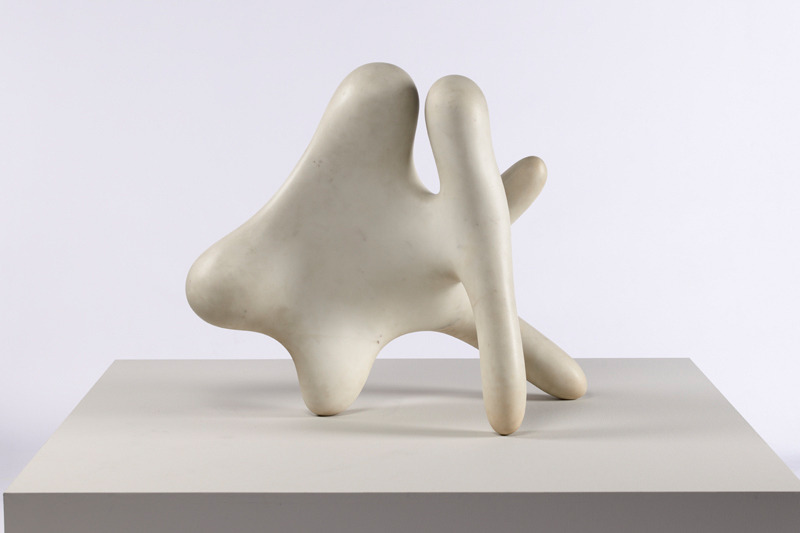
Photo: Otani Ichiro

In the front area, we present plasters made during the sculptural production process by Jean (Hans) Arp (1886–1966), along with sculptures from the 1950s and 1960s that explore biomorphic forms. In the wake of wars that claimed many lives and left both physical and spiritual scars, artists in both Japan and Europe reaffirmed life through organic forms in their work. Please take note not only of the forms themselves but also of the unique qualities of materials such as wood, clay, and plaster.
The back area features portraiture in Nihonga (Japanese-style painting). In the 1930s, Kaburaki Kiyokata (1878–1972) sought to reinvigorate art by exploring new possibilities in portrait painting, which had previously been rare in Nihonga. His Portrait of San’yutei Encho (1930), now designated an Important Cultural Property, was his first work in the genre and vividly portrays a well-known rakugo storyteller. This area introduces later developments in Nihonga portraiture, including paintings by the individuals who served as subjects.
2F (Second floor)
Room 11–12 1970s–2020s
From the End of the Showa Period to the Present
Room 11 Memory and Recollection

This room presents contemporary works that evoke historical events in various ways. Since the late 20th century, artists have increasingly engaged with the past not by depicting history directly, but by adopting diverse perspectives and methods. In his Today’s Painting series, in which each work shows only a date, Kawara On invites viewers to reflect on the nature of time itself. Other artists critically examine history through archival materials. Following the renewal of interest in Showa era (1926-1989) history after the death of Emperor Showa (Hirohito), Shimada Yoshiko produced etchings incorporating press photographs from World War II, reexamining images of women during wartime. Meanwhile, in photography, rather than seeking to capture decisive moments, certain photographers turn their attention to the circumstances underlying events. Yoneda Tomoko visits the sites of disasters such as wars, capturing traces of history that quietly persist in the present. Homma Takashi photographed forests and mushrooms in the wake of the Fukushima nuclear accident, focusing on unseen changes unfolding in nature. Together, these works present diverse and intriguing ways of conveying the past in the present.
Room 12 World Disrupted, Senses Opened

Photo: Otani Ichiro
This room presents Japanese contemporary art from the late 1980s to the present, focusing on appropriation of found objects and fluidity of meaning. Since the 1990s, in sculpture, artists such as Terauchi Yoko, Takayanagi Eri, Hakamata Kyotaro, and Tomii Motohiro have incorporated readymade objects into their works to subtly shift the meanings and functions of everyday things. This sensibility of displacement and substitution can also be seen in photography and painting from the same period. Onodera Yuki and Kitano Ken reinterpret the human figure through varied approaches that subvert conventions of photographic portraiture. By pairing poetic titles with abstract paintings, Okazaki Kenjiro frames his works not merely as visual experiences, but as devices that open the mind and the senses. These practices, which open up new ways of seeing by transforming meaning and disrupting perception, represent one of the defining tendencies in the art of this era.
Hours & Admissions
- Location
-
Collection Gallery, from the fourth to second floors
- Date
-
November 5, 2025–February 8, 2026
- Closed
-
Mondays (except November 24, January 12), November 25, December 28–January 1, and January 13
- Time
-
10 am–5 pm (Fridays and Saturdays open until 8 pm)
- Last admission: 30 minutes before closing.
- Admission
-
Adults ¥500 (400)
College and university students ¥250 (200)- The price in brackets is for the group of 20 persons or more. All prices include tax.
- Free for high school students, under 18, seniors (65 and over), Campus Members, MOMAT passport holder.
- Show your Membership Card of the MOMAT Supporters or the MOMAT Members to get free admission (a MOMAT Members Card admits two persons free).
- Persons with disability and one person accompanying them are admitted free of charge.
- Members of the MOMAT Corporate Partners are admitted free with their staff ID.
- Including the admission fee for MOMAT Collection Focus (Gallery 4).
- Discounts
-
Evening Discount (From 5 pm on Fridays and Saturdays)
Adults ¥300
College and university students ¥150 - Organaized by
-
The National Museum of Modern Art, Tokyo
Accessibility
We do our best to make it possible for all visitors to enjoy the artwork at their leisure.
- Information at the reception desk
- Loan wheelchairs and baby carriages
- Writing tablets
- Photography in the galleries (use of flash is not allowed)However, photography may not be allowed for some exhibitions and artworks.
- Service dogs are allowed.
- Coin lockers
- Parking (exclusively for visitors with reduced mobility)
- There are numerous seating areas inside the museum building.
- Multi-purpose toilet
- First-aid station
- Nursing room


